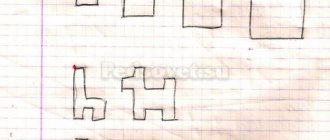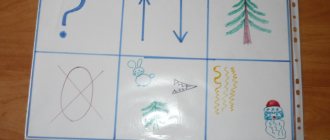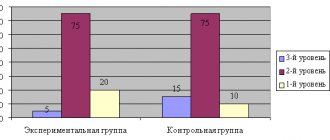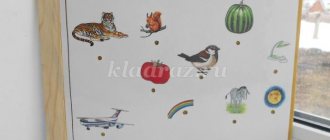Finger Theater
Finger theater is an exciting game that:
- Stimulates the development of fine motor skills;
- Introduces the child to the following concepts of shape, color, size;
- Helps develop spatial perception (the concepts of “right”, “left”, “next to each other”, etc.);
- Develops imagination, memory, thinking and attention;
- Helps develop vocabulary and activates speech functions;
- Forms creative abilities and artistic skills;
- Introduces basic mathematical concepts.
For children aged 1 – 2 years (using the example of the fairy tale “Kolobok”):
- First, introduce your child to the characters in the fairy tale. Invite your child to look at and touch the figures. Then put each character on your finger in turn and describe it.
- Introduce your child to the name of each finger on his hand. For example, you can say this: “I have a Kolobok sitting on my index finger.”
- Then act out a fairy tale for your child. Place the characters on your fingers and cross your arms. Start telling the story, raising your fingers with the characters as the action progresses. For example, the fairy tale “Kolobok” can be told as follows. Thumbs up with Grandma character. Tell your child that today this hero will bake Kolobok. Rhythmically tap the heels of your palms against each other without releasing your fingers. At the same time, say: “Grandma is kneading the dough.” Using the same principle, play up the appearance of each character.
For children aged 2 – 4 years (using the example of the fairy tale “Kolobok”):
- Ask your child if he remembers the fairy tale “Kolobok”. Remind him if necessary.
- Then ask your child to place the characters on the table in the order they appear in the story. At the same time, ask to characterize each of them according to the principle: “Grandma is old, kind, caring; Kolobok is round, ruddy, mischievous,” etc.
- Ask your child questions about the fairy tale. For example: “Why did grandma decide to bake Kolobok? Why did he leave his grandmother and grandfather? Who did he meet on the way?
- Then act out a fairy tale in front of the little spectator using a finger theater.
- At the end, ask your child to act out a fairy tale in front of you using a finger theater. If necessary, prompt him.
Finger games for speech development
The essence of the finger motor skills lesson is to teach the child to use his fingers to depict some objects or living beings. In this case, all finger movements must be explained to the baby. This will help the child understand concepts such as “top”, “bottom”, “right”, “left”, etc. After the child learns how to do the exercises himself, you can try to act out scenes or short fairy tales, distributing the roles among yourself and your little actor (for example, a meeting between a hedgehog and a bunny in the forest). Here are some examples of such exercises.
- Finger game “Bunny”. The index and middle fingers are straightened, the rest are clenched into a fist. Little man. “Run” with your index and middle fingers on the table. Finger game “Hedgehog”. Clasp your hands, straighten the fingers of one hand and the thumb of the other. Cat. Connect the middle and ring fingers with the thumb, raise the index and little fingers up. Horned goat. The index and little fingers are straight, the thumb is on the bent ring and middle fingers. Butterfly. Cross your hands at the wrists and press your palms with the backs of your hands facing each other, fingers straight; palms with straight fingers make slight movements in the wrists - “butterfly flies.” Glasses. Fold the fingers of your right and left hands into rings and bring them to your eyes.
In addition to these examples, you yourself can come up with many interesting and entertaining exercises for your child to develop speech.
How to develop a child's speech
We continue the conversation about the development of a child’s speech , which began in the first part of the article devoted to this problem.
The movements of the body and organs involved in speech production have common mechanisms, therefore the development of fine motor skills of the hands directly affects the development of speech. It is for this reason that finger exercises for the development of speech in children should take a strong place in your activities with your child.
Training finger movements will, as it were, prepare a platform for further speech development. You can start training your baby’s fingers within the first 5 months.
Now let's see how you can help your child master their native speech, teach him correct pronunciation, constructing phrases and forming thoughts.
Remember: classes should be held in the most easy, fun and playful way possible. Then they will bring real benefits and bring real pleasure to both of you.
A set of measures for speech development (to be carried out at home):
- Development of fine motor skills
- Speech gymnastics
- Logorhythmics
We do not mention here such areas of work on speech development as speech therapy massage, special exercises for practicing various sounds, developing phonemic hearing, and some others. They are the area of application of exclusively professional knowledge and skills. Here it is better to trust a specialist rather than try to cope with this task yourself.
Benefits for developing fine motor skills:
- Matryoshka dolls
- Velvet paper
- Plasticine
- Mosaic
- Laces
- Beans, peas
- Semolina
- Salty dough
- Counting sticks
- Multi-colored clothespins
- Beads
- Cloths with sewn buttons
- Stencils
- Massage ball
- Wooden construction sets
Fine motor skills:
- Passive gymnastics - massage for the development of fine motor skills.
- Active gymnastics - games for the development of fine motor skills: poems and nursery rhymes, finger games, finger theater.






